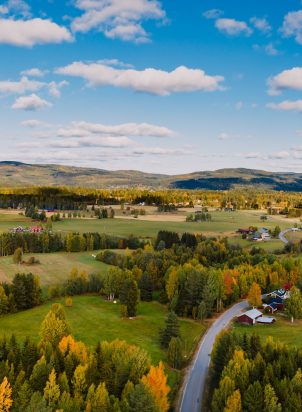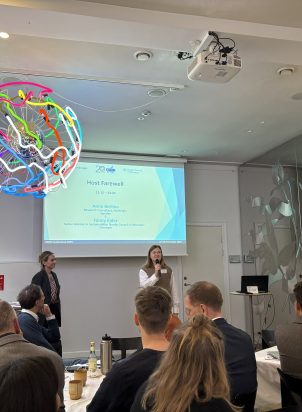Cross-border activities came dramatically to a halt in the spring of 2020 as a result of measures adopted to limit the spread of the Coronavirus. The ability to work, socialise, do business and use services across borders is an integral part of daily life in border communities all across the Nordic countries and Europe. Since the pandemic hit, border communities have faced extraordinary challenges as national borders were suddenly closed and various other restrictions were put in place. These obstacles were at the centre of attention at an online event “Strengthening cross-border communities: Lessons from Covid-19” organised by Nordregio together with the Bothnian Arc and Svinesund cross-border committees on the 12th November 2020.
By Páll Tómas Finnsson, Communications consultant at Finnsson & Co

Increased awareness of the value of cross-border cooperation
“In times of crisis, it’s always possible to find opportunities,” said Martin Guillermo Ramírez, Secretary General of the Association of European Border Regions. He gave a European perspective on the challenges facing border regions, not only because of the pandemic but also in light of political developments such as Brexit and the increasing nationalism throughout Europe. In his talk, Ramírez emphasised that the current challenges should be regarded as an opportunity to further boost cross-border collaboration in the future.
“Many of the nation states in Europe decided to close their borders to contain the pandemic, but in some cases, they were reopened less than 24 hours later because of the high level of interaction in the border areas,” he explained. According to Ramírez, the situation has brought the importance of integrated border communities higher up on both the national and European agendas.
“This represents an important turn of events, considering that we started the year with the announcement that there would be a budget reduction for cross-border cooperation in the EU,” Ramírez adds. “Now, there is a proposal on the table to increase funds for territorial cooperation from the recovery package.”
Difficulties for tight-knit border communities
Just one year ago, the closing of the Nordic borders would have been unthinkable. Systematic border control between the countries was abolished in 1954, and since then, the Nordic populations have enjoyed the benefits of free labour mobility and increased integration across Nordic states. However, passport controls introduced during the migration crisis in 2015 showed a first sign of weakened Nordic cooperation.
“The closing of the border between Finland and Sweden due to the pandemic created a lot of problems for our region,” says Heikki Aalto, CEO of the Bothnian Arc, one of twelve cross-border committees financed partly by the Nordic Council of Ministers. “Labour mobility was and still is restricted. The most significant impacts are however experienced by families that live on both sides of the border and those who need to access services, for instance, shopping, schools, healthcare and other public services.”
Many of the difficulties, says Aalto, were caused by differences in legislation between the two neighbouring countries and not least by the extremely different approaches to the pandemic. Whereas Finland imposed a lockdown and placed armed guards at the border, Sweden, as has become well known, took a more lenient approach to curb the spread of the virus and never closed its borders.
Nordregio researcher Alberto Giacometti explained that in the case of Haparanda and Tornio, two cities located right next to each other on the border, a fence was set up across the town square that connects the two cities. Despite being functionally co-dependent, no exception was made to allow crossings between the twin cities. By May 2020, Finnish authorities estimated that the number of border crossings had dropped 91% compared to the 2019 average.
”Later, exceptions were made for frontier workers and border communities, making it easier to cross the border,” Giacometti says. ”This improved the situation but also sparked significant criticism and debate on where to draw the line when defining who is a border commuter and who is not.”
More resilient cross-border communities
The Bothnian Arc and Svinesund cross-border committees have both been involved in Nordregio’s efforts to analyse regional resilience in the Nordic countries. The research has been commissioned by the Nordic Thematic Group on Innovative and Resilient Regions. The concept of resilience addresses the capability of a community or a region to cope with change, whether it be shocks, such as the Covid-19 pandemic, or stress, which describes more gradual problems, as for instance demographic decline or an ageing population.
”Regional resilience is more relevant than ever,” says Elsie Hellström, CEO of the Svinesund Committee. Heavily dependent on cross-border trade and tourism, the Svinesund region has been severely impacted by the pandemic. The most explicit example is found in Swedish Strömstad, which registered a 75 per cent increase in unemployment after Norway effectively closed its borders.
“We firmly believe that by carefully analysing the ways in which different groups have been affected by the closed borders, we can get out of this crisis together and return to working for a more sustainable and integrated Nordic Region.”
According to Mari Wøien Meijer, researcher at Nordregio, global trends and developments should be taken into account when working with regional resilience, particularly now when designing recovery plans from the pandemic.
“Firstly, it’s important to ensure that the transition is green and that it moves the communities towards a more circular economy. Additionally, the effort should be aligned with the Sustainable Development Goals and major global drivers, including key demographic trends and industrial renewal with increased digitalisation and automation.”
“Within the Nordic Thematic Group on Innovative and Resilient Regions, we show that smart-specialisation, skills development and digitalisation can be used as instruments to strengthen regional resilience” Meijer explains. “This means that the regions are encouraged to think in new ways and take on an entrepreneurial role to achieve their goals and ambitions. Not least to address potential risks and recover from crises, such as the one triggered by the Covid-19 pandemic.”
Addressing border obstacles
During the pandemic, the Nordic cross-border information services have played a crucial role in identifying and addressing various disturbances and obstacles in the border regions. These are the three regional information services Oresund Direct, the North Calotte Cross-Border Advice Service and Grensetjänsten Norway-Sweden, alongside Info Norden, which works across all the Nordics.
Statistics show that in 2017, there were about 45,000 commutes across the Nordic borders, and in 2019, around 38,000 people moved from one Nordic country to another. According to Sandra Forsén, Senior Advisor for the Freedom of Movement Secretariat at the Nordic Council of Ministers, these figures illustrate the widespread impact of the border closures.
“Together with the information services, we identified 44 different disturbances and obstacles in the cross-border regions. Around half of them affected those commuting across the border, 14 per cent had an impact on cross-border businesses, and 20 per cent affected personal or family relations across the borders.”
Bringing the Nordic model to Europe
As the first Nordic cross-border committee, Kvarken Council recently achieved legal status as a European Grouping of Territorial Cooperation (EGTC). The Council operates in the maritime border region between Finland and Sweden, across the narrowest point of the Bothnian Bay. At the event, Ann-Sofi Backgren, Project Manager at Kvarken Council and Vice-President of AEBR, encouraged other Nordic border committees to also look more toward Europe.
“The pandemic has shown us that we must further develop our risk management and intensify cross-border planning on issues such as security, health, labour market, civil society and people-to-people activities,” Backgren said.
Both Ramírez and Backgren highlighted the complex landscape in which border committees will have to operate in the future to secure the resilience of border communities. In addition to the work done locally, they will have to work much more actively at national and European levels.
“In doing that, it’s important that the we continue to push the green and digital agendas,” says Backgren. “I think it’s time that we boost this Nordic brand of cross-border cooperation as a tool to strengthen integration in border regions, both in the Nordic countries and in Europe.”





